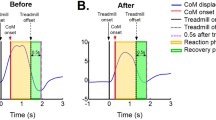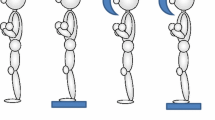Abstract
This paper presented the 8-weeks training effects of training system based on an unstable platform and a visual interactive system for improving the ability of postural control. To confirm the effects of the training, fifteen elderly volunteers took part in a series of balance training using this system. Fifteen elderly volunteers as the control group compared with the training group. To evaluate the effects of the training, the relevant parameters such as the time of timed up and go (TUG) test, the transfer limits of the different directions, the sway path of center of pressure (COP), and the root mean square (RMS) of COP in anteroposterior (AP) direction and mediolateral (ML) direction, concentric isokinetic strength of ankle and knee joints were measured from pre-training to post-training. The results showed that the training system could successfully assess the gradual improvement of the postural control capability of the volunteers in the system and showed a possibility of improving balance capability of the volunteers. Moreover, the significant improvement in the postural capability of the elderly suggested that the elderly could benefit more from the training using the system for the improvement of the ability of postural control.
Similar content being viewed by others

References
Kim, K., Yu, C. H., Yu, M., Jeong, G. Y., Ko, D. Y., and Kwon, T. K., “The Effects of a Powered Ankle Exoskeleton for Plantarflexion Torque Assistance for the Elderly,” Int. J. Precis. Eng. Manuf., Vol. 14, No. 2, pp. 307–315, 2013.
Horak, F. B., Shupert, C. L., and Mirka, A., “Components of Postural Dyscontrol in the Elderly: A Review,” Neurobiology of Aging, Vol. 10, No. 6, pp. 727–738, 1989.
Rosenhall, U., “Degenerative Patterns in the Aging Human Vestibular Neuro-Epithelia,” Acta Oto-laryngologica, Vol. 76, No. 1–6, pp. 208–220, 1973.
Bergström, B., “Morphology of the Vestibular Nerve: III. Analysis of the Calibers of the Myelinated Vestibular Nerve Fibers in Man at Various Ages,” Acta Oto-laryngologica, Vol. 76, No. 1–6, pp. 331–338, 1973.
Rosenhall, U. and Rubin, W., “Degenerative Changes in the Human Vestibular Sensory Epithelia, Acta Oto-laryngologica, Vol. 79, No. 1–2, pp. 67–80, 1975.
Laughton, C. A., Slavin, M., Katdare, K., Nolan, L., Bean, J. F., and et al., “Aging, Muscle Activity, and Balance Control: Physiologic Changes Associated with Balance Impairment,” Gait and posture, Vol. 18, No. 2, pp. 101–108, 2003.
Lord, S. R., Ward, J. A., Williams, P., and Anstey, K. J., “Physiological Factors Associated with Falls in Older Community-Dwelling Women,” Journal of the American Geriatrics Society, Vol. 42, No. 10, pp. 1110–1117, 1994.
Whipple, R., Wolfson, L., and Amerman, P., “The Relationship of Knee and Ankle Weakness to Falls in Nursing Home Residents: An Isokinetic Study,” Journal of the American Geriatrics Society, Vol. 35, No. 1, pp. 13–20, 1987.
Buchner, D. M., Cress, M. E., de Lateur, B. J., Esselman, P. C., Margherita, A. J., and et al., “The Effect of Strength and Endurance Training on Gait, Balance, Fall Risk, and Health Services use in Community-Living Older Adults,” The Journals of Gerontology Series A: Biological Sciences and Medical Sciences, Vol. 52, No. 4, pp. M218–M224, 1997.
Cress, M. E., Buchner, D. M., Questad, K. A., Esselman, P. C., and Schwartz, R. S., “Exercise: Effects on Physical Functional Performance in Independent Older Adults,” The Journals of Gerontology Series A: Biological Sciences and Medical Sciences, Vol. 54, No. 5, pp. 242–248, 1999.
Hamman, R. G., Mekjavic, I., Mallinson, A. I., and Longridge, N. S., “Training Effects during Repeated Therapy Sessions of Balance Training using Visual Feedback,” Archives of Physical Medicine and Rehabilitation, Vol. 73, No. 8, pp. 738, 1992.
Hess, J. A. and Woollacott, M., “Effect of High-Intensity Strength-Training on Functional Measures of Balance Ability in Balance-Impaired Older Adults,” Journal of Manipulative and Physiological Therapeutics, Vol. 28, No. 8, pp. 582–590, 2005.
Morioka, S. and Yagi, F., “Influence of Perceptual Learning on Standing Posture Balance: Repeated Training for Hardness Discrimination of Foot Sole,” Gait and posture, Vol. 20, No. 1, pp. 36–40, 2004.
Seidler, R. D. and Martin, P. E., “The Effects of Short Term Balance Training on the Postural Control of Older Adults,” Gait and Posture, Vol. 6, No. 3, pp. 224–236, 1997.
Granacher, U., Gollhofer, A., and Strass, D., “Training Induced Adaptations in Characteristics of Postural Reflexes in Elderly Men,” Gait and posture, Vol. 24, No. 4, pp. 459–466, 2006.
Page, P., “Sensorimotor Training: A Global Approach for Balance Training,” Journal of Bodywork and Movement Therapies, Vol. 10, No. 1, pp. 77–84, 2006.
Kim, J. W., Chung, H. Y., Kim, C. S., Jun, J. H., Park, B. K., Eom, G. M., “Relationship between Body Factors and Postural Sway during Natural Standing,” Int. J. Precis. Eng. Manuf., Vol. 13, No. 6, pp. 963–968, 2012.
Podsiadlo, D. and Richardson, S., “The Timed Up & Go: a Test of Basic Functional Mobility for Balance-Impaired Elderly Persons,” Journal of the American Geriatrics Society, Vol. 39, No. 2, pp. 142–148, 1991.
Piao, Y. J., Kwon, T. K., Kim, D. W., and Kim, N. G., “Development of a New Training System for Improving the Postural Control Ability of Elderly Adults,” Journal of Mechanical Science and Technology, Vol. 23, No. 2, pp. 324–334, 2009.
Jeka, J. J. and Lackner, J. R., “The Role of Haptic Cues from Rough and Slippery Surfaces in Human Postural Control,” Experimental Brain Research, Vol. 103, No. 2, pp. 267–276, 1995.
Clapp, S. and Wing, A. M., “Light Touch Contribution to Balance in Normal Bipedal Stance,” Experimental Brain Research, Vol. 125, No. 4, pp. 521–524, 1999.
Lackner, J. R., Rabin, E., and DiZio, P., “Stabilization of Posture by Precision Touch of the Index Finger with Rigid and Flexible Filaments,” Experimental Brain Research, Vol. 139, No. 4, pp. 454–464, 2001.
Dickstein, R., Shupert, C. L., and Horak, F. B., “Fingertip Touch Improves Postural Stability in Patients with Peripheral Neuropathy,” Gait and Posture, Vol. 14, No. 3, pp. 238–247, 2001.
Shumway-Cook, A., Brauer, S., and Woollacott, M., “Predicting the Probability for Falls in Community-Dwelling Older Adults using the Timed Up and Go Test,” Physical Therapy, Vol. 80, No. 9, pp. 896–903, 2000.
Wallmann, H. W., “Comparison of Elderly Nonfallers and Fallers on Performance Measures of Functional Reach, Sensory Organization, and Limits of Stability,” The Journals of Gerontology Series A: Biological Sciences and Medical Sciences, Vol. 56, No. 9, pp. 580–583, 2001.
Rogers, M. E., Rogers, N.L., Takeshima, N., and Islam, M. M., “Methods to Assess and Improve the Physical Parameters Associated with Fall Risk in Older Adults,” Preventive Medicine, Vol. 36, No. 3, pp. 255–264, 2003.
Author information
Authors and Affiliations
Corresponding author
Rights and permissions
About this article
Cite this article
Yu, CH., Piao, Y.J., Kim, K. et al. The effects of an 8-weeks training on postural control for the elderly. Int. J. Precis. Eng. Manuf. 15, 161–168 (2014). https://doi.org/10.1007/s12541-013-0320-7
Received:
Accepted:
Published:
Issue Date:
DOI: https://doi.org/10.1007/s12541-013-0320-7



